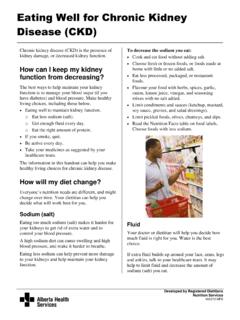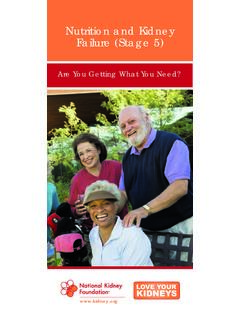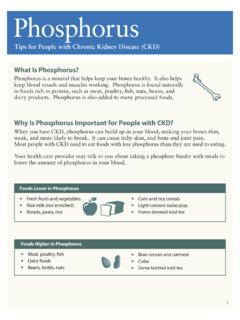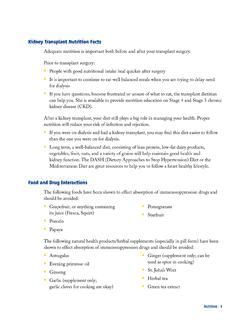Transcription of Developing Community-Based Programs for People with …
1 Developing Community-Based Programs for People with DiabetesAn Introduction for Community Based OrganizationsUsing this training This is a printable version of the Developing Community Based Programs for People with diabetes training. It has all of the information included in the online version. Words and phrases that are underlinedwill be defined on the following page. Communities in Action Stories and the Tools and Resources Handout are provided in a separate file. You can: Print out a copy to take notes while you take the online version of the training. Save a copy to use as a reference ObjectivesBy the end of this training you will be able to:1)Describe the role of Community-Based organizations in providing support to People with )Describe the steps involved in planning Community-Based diabetes )Identify resources to support planning, implementing, and evaluating Community-Based diabetes do you think your organization can do to help People with diabetes ?
2 Don t know. I didn t think there was anything we could do to help. Part 1 of this training will provide an introduction to the kinds of education and support People with diabetes need. You will learn about the important roles organizations like yours can think we can do something. But where do we start? Part 2 of this training will review strategies used by Community-Based organizations to support People with diabetes along with key steps in planning diabetes Programs . You will learn about how to get know we can help. We need effective resources that will help us make a difference. Part 3 of this training will direct you to tools designed to help Community-Based organizations plan and do diabetes organizations play an important role in the lives of People with training will introduce you to the important role that Community-Based organizations play in helping People with diabetes lead healthier lives.
3 You will learn about strategies that have been shown to help improve the health and quality of life of People with diabetes , and you will be introduced to tools and resources to help you get MenuYou can go through all three sections, or pick the section that will meet your needs right now. Complete all 3 sections to earn continuing education )Part 1: Education and Support for People with diabetes An overview of the kinds of education and support needed by People with )Part 2: Planning Community-Based Activities An introduction to the strategies used by Community-Based organizations to support People with )Part 3: Tools and Resources Tools designed to help Community-Based organizations implement diabetes activities and programsPart 1: Education and Support for People with DiabetesMy name is Susan.
4 I have diabetes . I am one of the estimated 29 million Americans who live with diabetes . What do you think is on my to-do list for today?My to-do list probably looks a lot like yours. But, on top of everything else, I have to take steps each day to manage my Pay bills Get laundry Pick up kids. Check blood sugar (glucose). Check feet. Walk for 30 minutes. Take my medicine. Go to eye doctor. Go to diabetes self-management list includes things I have to do every day, like checking my blood sugar, taking medicine, eating healthy foods, and getting physical activity along with managing my blood pressure and cholesterol.
5 I have to learn to solve problems, find healthy ways to cope with my diabetes , and take steps to reduce my risk for complications from diabetes . I must also be sure to receive regular preventive care for my teeth, eyes, feet, and Pay bills Get laundry Pick up kids. Check blood sugar (glucose). Check feet. Walk for 30 minutes. Take my medicine. Go to eye doctor. Go to diabetes self-management is serious. While heart disease is the leading cause of death for People with diabetes , it can affect every part of my body. diabetes can lead to complications like: eye disease kidney disease nerve damage foot sores and amputations People with diabetes are also more likely to suffer from depression than People without diabetes .
6 diabetes is also expensive. My medical costs are more than twice as high as a person without diabetes . It is estimated that the total cost of diabetes in the in 2012 was $245 billion diabetes is not easy, but with the right care and support I can do it!Like everyone with diabetes , I must: Learn about diabetes . Learn how to take care of my diabetes . Learn to cope with living with diabetes . Get routine medical the right support and care I can manage my diabetes and lower my chances for diabetes is a team effortManaging diabetes is a team effort that involves health care providers, diabetes self-management education, family and friends and community support.
7 You have already learned about what I must do to take care of my health. In this section you will learn about more about each team member s role in supporting this section, you will learn about the roles Care Self Management and friendsI am Susan s primary health care provider. I am responsible for managing her medical care. I diagnosed her diabetes . I also prescribe her treatments and set goals for her health. These goals include helping her manage her A1C, blood pressure and cholesterol. During Susan s regular visits, I will monitor her health to help reduce her chances of getting complications. If she does develop complications I will provide treatment or send her to a learn more about recommendations for diabetes management download Tips to Help You Stay Healthy with diabetes from A1 CThe A1C is a blood test that measures a person's average blood sugar level over the past three months.
8 You need to know your blood sugar levels over time because you don t want those numbers to get too high. High levels of blood sugar can harm your heart, blood vessels, kidneys, feet, and eyes. Blood pressureis the force of your blood against the wall of your blood vessels. If your blood pressure gets too high, it makes your heart work too hard. It can cause a heart attack, stroke, and damage your kidneys and eyes. Cholesterolis a waxy, fat-like substance that your body needs. There are two kinds of cholesterol in your blood: LDL and HDL. LDL or bad cholesterol can build up and clog your blood vessels. It can cause a heart attack or stroke.
9 HDL or good cholesterol helps remove the bad cholesterol from your blood Care ProvidersThere are many different health care providers who support People with diabetes . Doctors, nurses/nurse practitioners and physician s assistants help manage the general care for People with diabetes . diabetes educators and community health workers help People with diabetes and their families learn about how to manage diabetes and how to find resources in the community. You will learn more about both in the diabetes education section. Pharmacists help manage medications and provide advice. Some pharmacists teach diabetes Self Management Education.
10 Eye doctors, dentists and foot doctors check for diabetes related complications related to the eyes, teeth and feet. Health Care ProvidersThere are many different health care providers who support People with diabetes . Some People with diabetes may also need to see specialists like a kidney doctor or diabetes specialist. They help prevent and manage diabetes -related complications Dieticians help People with diabetes learn to manage their diabetes through healthy eating. Social workers help People with diabetes and their families coordinate medical care and may help with other issues like insurance. Mental health professionals may help People with diabetes learn to cope with the emotional side of living with with health care providersSusan needs to keep track of her medical appointments and the treatments her health care providers recommend.














